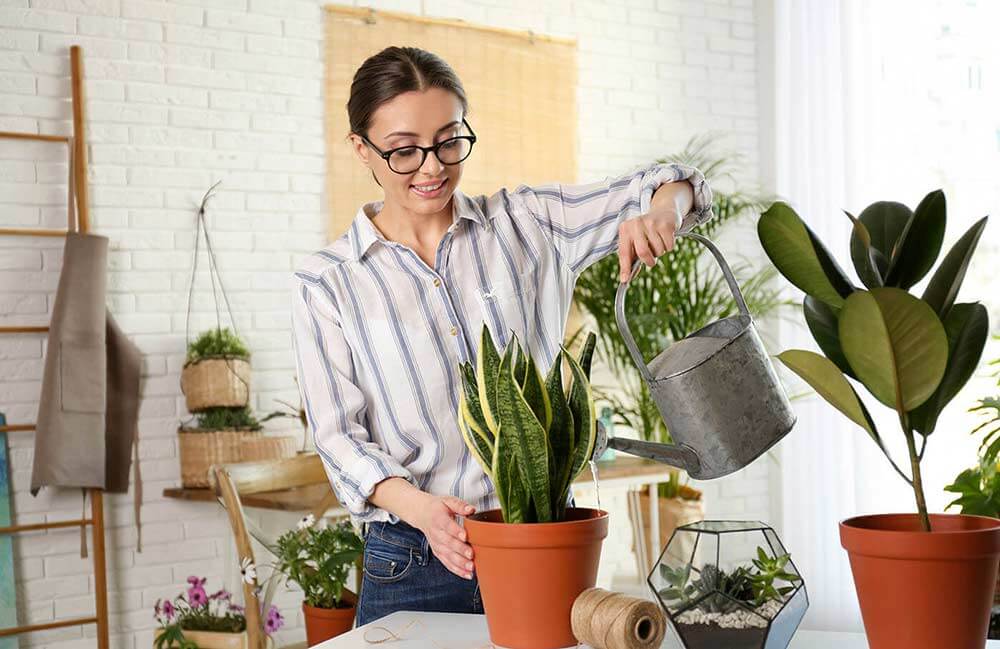
Whether you’re looking for a little greenery on your windowsill or a full-on jungle in your living room, houseplants are an essential part of any interior upgrade and provide a welcome dose of life and colour during the winter months. Creating the indoor tropical garden of your dreams, however, isn’t as easy as just bringing home a carload of potted plants and setting them up around the house. Each species of plant has its own unique requirements for soil, light and temperature, and some are definitely easier to please than others.
For first-time plant parents (or serial plant killers), these easy-care species will brighten your space while standing up to all manner of drafts, droughts and neglect. If you have pets, just make sure to check that the plants you bring home are safe, as some species can be toxic to curious dogs and cats.
Snake plant Aloe vera Christmas cactus Pothos Jade Lucky bamboo Spider plant
Snake plant
Sansevieria trifasciata, also known as “mother-in-law’s tongue” or snake plant, is one of the most popular house plants for a reason: it is big, exotic-looking, and very difficult to kill. This plant, native to Southern Africa, will do well in bright, indirect sunlight, but it’s pretty easy-going as far as light is concerned. The only things that it really doesn’t like are soggy soil and freezing temperatures, so keep it clear of drafty windows and water it only when the soil is totally dry.
Aloe vera
Not only do the aloe’s spiky fronds look pretty, their sap is also a topical remedy for treating burns and scrapes. Not bad for a plant that can happily go weeks without watering. Just place your aloe in indirect sunlight and water it occasionally (every 3 weeks in summer, and less frequently in the winter). If the leaves start to turn yellow, it could be a sign that you’re overwatering your aloe, or it’s getting too much sun.
Christmas cactus
This hardy house plant’s name is a bit of a misnomer, as it comes from the rainforests of Brazil, not the desert. It does, however, provide a lot of bang for its low-maintenance buck in the form of vibrant-coloured flowers that appear in fall or winter. Given their origins, these plants like indirect light and humidity, but not soggy soil. For maximum flowering, prune a few sections off every branch in early summer. These trimmings can then be easily rooted to produce even more plants.
Pothos
This native of the Polynesian islands is now a common sight in many homes around the world. As you may have guessed, the reason for this popularity is the fact that pothos grows easily in many indoor settings, and doesn’t require a lot of care other than the occasional watering. Happiest in humid air and indirect light, pothos have long, slender vines that can be trained across bookshelves or can dangle from a hanging basket.
Jade
An adorable succulent with plump emerald green leaves, tiny jade plants can grow to more than a metre in height if well cared for. Fortunately, keeping your jade happy is as simple as keeping its soil moist in spring and summer, and mostly leaving it alone through fall and winter. As a succulent, a jade doesn’t need a lot of water but it does require a few hours of direct sunlight each day in order to thrive. Take good care of your jade and it could live for decades.
Lucky bamboo
We’re all familiar with dracaena sanderiana, whose popularity began in East Asian cultures where it is associated with good fortune. What most people don’t know is that lucky bamboo isn’t a bamboo at all, but instead more closely related to the succulent family. Perhaps the easiest plant to care for on this list, lucky bamboo doesn’t actually require soil at all, and can thrive in a vase or glass of water. Just stabilize the stem in some glass pebbles or clean rocks, change the water when it gets murky, and don’t let the roots dry out. That’s pretty much it!
Spider plant
Your friendly neighbourhood spider plant is a childhood classic for anyone who grew up in the 1970s, perhaps because it lends itself so well to the macrame plant hangers popular in the era. Today the humble spider plant is still a great choice for novice indoor gardeners, requiring moderate, indirect light and moist soil. Treat your spider well and it will reward you with vines sprouting little baby plants that give it its name.
Jeremy Freed is a freelance writer and editor based in Toronto. His writing about fashion, travel, food and design appears in Sharp, Harry and re:Porter magazines, among many others.